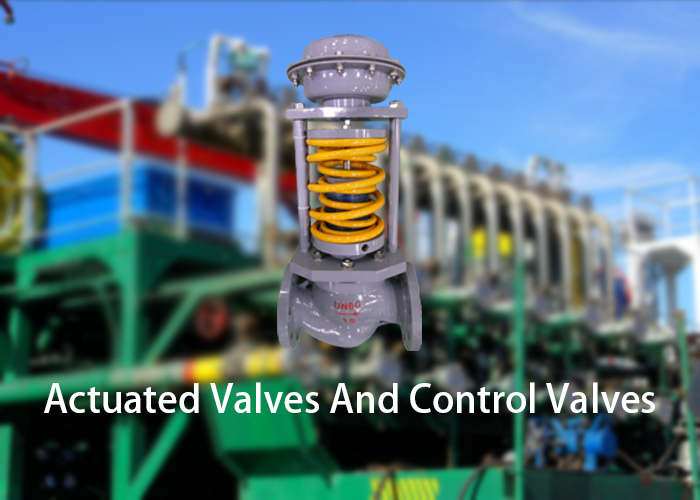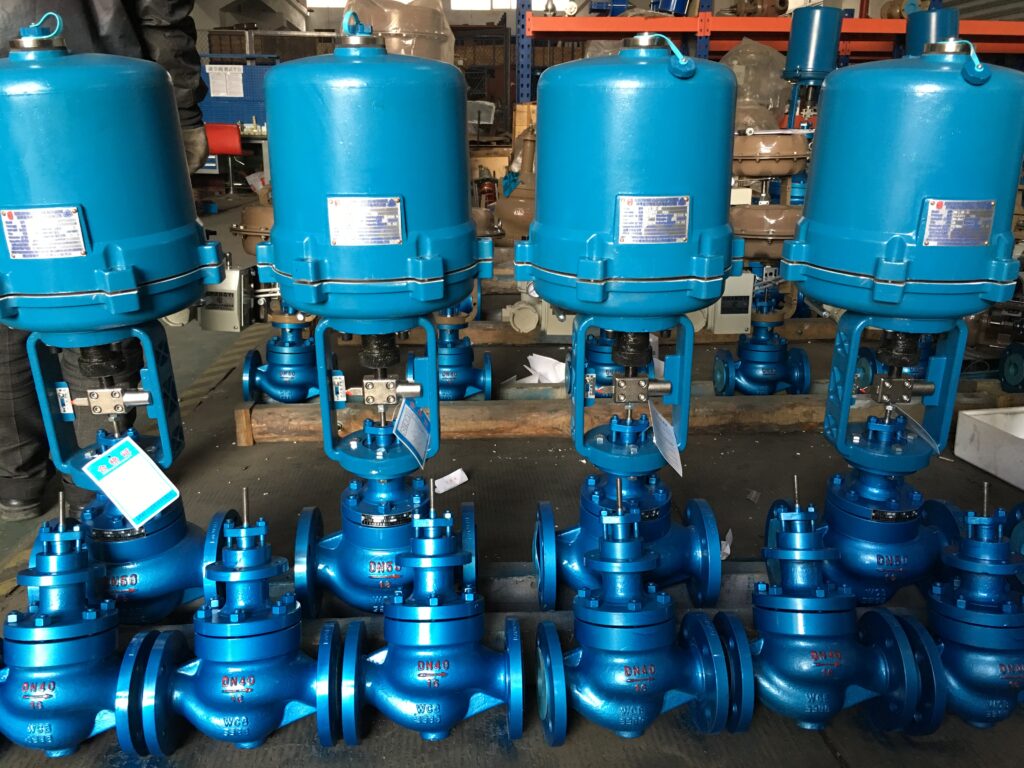
Selecting the right valve for industrial production is critical to achieving optimum system performance and efficiency. Actuated and control valves are two valves extensively utilized in various industries. Understanding the distinctions between multiple valve types and how to select the best one for a given application is critical for providing accurate flow control and meeting process requirements. In this blog post, we will look at the distinctions between actuated and control valves and offer advice on choosing the best valve for your unique needs. By the end, you will better grasp the aspects to consider when deciding between actuated valves and control valves, allowing you to make informed decisions and optimize your industrial operations.
Ⅰ. Actuated Valves
Definition and Functionality of Actuated Valves:
Actuated valves are those that include an actuator, which is a mechanical device that controls the valve. The actuator can be powered by electrical, pneumatic, or hydraulic means. Actuated valves use the energy or pressure of the process fluid to actuate and regulate the position of the valve. These self-operating valves do not require external control signals or power sources.
Key Features and Components of Actuated Valves:
- Actuator: The actuator is the core component of an actuated valve. It converts energy from a power source into mechanical motion to open, close, or modulate the valve.
- Valve body: The valve body provides the passage for fluid flow and houses the valve’s internal components.
- Trim: The trim consists of the disc, seat, and other flow control elements that regulate the fluid flow through the valve.
- Stem: The stem connects the actuator to the valve trim and transfers the motion and force from the actuator to control the valve’s position.
Advantages and Disadvantages of Actuated Valves:
Advantages:
- Self-operated: Actuated valves do not require external control signals or power sources, making them suitable for applications with limited or unavailable resources.
- Simple design: Actuated valves are often more straightforward than control valves, resulting in lower maintenance requirements and reduced costs.
- Suitable for remote locations: Actuated valves are ideal for remote or hard-to-reach locations where running control signals or power lines may be impractical.
Disadvantages:
- Limited control capabilities: Actuated valves offer limited control strategies compared to control valves, limiting the precision and sophistication of flow control.
- Reduced accuracy: Actuated valves may have lower accuracy in maintaining precise setpoints than control valves.
- Less flexibility: Actuated valves are not easily adjustable or adaptable to changes in process conditions or control requirements.
Typical Applications and Industries that benefit from Actuated Valves:
- Oil and gas production and refining
- Chemical manufacturing
- Water and wastewater treatment
- Power generation
- Mining and mineral processing
- Pulp and paper industry
- Food and beverage processing
- HVAC systems
Ⅱ.Control Valves
Control valves use external signals to accurately adjust fluid flow, pressure, or temperature. They maintain desirable setpoints by providing continuous and accurate control of process variables. Control valves comprise three parts: a valve body, a movable element like a plug or a ball, and an actuator that responds to control signals from a central control system. The actuator positions the valve to obtain the required flow rate or process conditions.
Key Features and Components of Control Valves:
- Valve body: The valve body provides the passage for fluid flow and contains the internal components.
- Trim: The trim includes the valve seat, plug, or ball, which determines the flow characteristics and regulates fluid flow.
- Actuator: The actuator receives control signals from a central control system and adjusts the valve’s position accordingly.
- Positioner: In some cases, control valves may include a positioner that further enhances the accuracy and response of the valve by providing precise control of the actuator.
Advantages:
- Precise control: Control valves offer precise control of flow, pressure, or temperature, allowing for accurate adjustment of process variables to meet setpoints.
- Advanced control strategies: Control valves can be integrated into complex control systems, such as PID control loops, enabling sophisticated control strategies for optimal process performance.
- Flexibility and adaptability: Control valves can be adjusted, tuned, and calibrated to accommodate process conditions and control requirements changes.
Disadvantages:
- Complexity: Control valves have a more intricate design than actuated valves, which may result in higher maintenance and installation costs.
- External control dependencies: Control valves rely on external control signals from a central control system, making them dependent on the availability and reliability of the control infrastructure.
- Energy requirements: Control valves often require external power sources to operate the actuators, which can increase energy consumption.
Typical applications and industries that benefit from control valves:
§ Petrochemical and refining processes
§ Pharmaceutical and biotechnology industries
§ Power plants
§ Water and wastewater treatment plants
§ HVAC systems and building automation
§ Food and beverage processing
§ Pulp and paper industry
§ Chemical processing

III. Differences Between Actuated Valves and Control Valves:
A. Operational principles and control mechanisms:
The energy or pressure of the process fluid controls actuated valves. An actuated valve’s actuator responds directly to changes in fluid pressure, allowing for self-operation and position control. Control valves, on the other hand, rely on external control signals from a central control system. The control system modifies the actuator, placing the valve to accomplish exact flow, pressure, or temperature control.
B. Energy requirements and power sources:
Actuated valves operate using the energy of the process fluid and do not require external power sources. They are frequently self-powered and operated. Control valves, on the other hand, often need external power sources to drive the actuators, such as electricity or compressed air. These power sources supply the energy required to position the valve based on control signals precisely.
C. Level of automation and external control signals:
Actuated valves are typically less automated than control valves. They operate without the use of external control signals or complicated control systems. Actuated valves are appropriate for applications that require a more straightforward control mechanism or when external control signals are limited. In contrast, control valves are widely utilized in automated systems that demand precise control and integration with central control systems. They can use advanced control techniques such as PID control and respond to external control signals.
D. Accuracy and precision in flow regulation:
Control valves provide more accuracy and precision in flow regulation than actuated valves. Control valves enable exact valve position adjustment based on control signals, allowing for fine-tuning flow rates or process variables to match desired setpoints. While actuated valves can control flow to some extent, they may achieve a different level of accuracy and precision than control valves.
Ⅳ.Selecting the Ideal Valve for Specific Applications:
A.Decision-making criteria for actuated valves:
- Fluid characteristics: Consider the properties of the fluid being controlled, such as viscosity, corrosiveness, and temperature. Ensure that the materials used in the actuated valve can withstand the fluid’s properties without degradation or damage.
- Flow requirements: Evaluate the desired flow rate, pressure drop, and flow control range needed for the application. Actuated valves may have limitations in achieving high flow rates or precise control over a wide range.
- Control objectives: Assess the level of control required for the application. Actuated valves offer simpler control mechanisms and are suitable for applications with sufficient essential control.
- Power availability: Determine the availability of external power sources. Actuated valves are self-operated and do not require external power, making them suitable for remote or power-limited locations.
- Maintenance and reliability: Consider the maintenance requirements and reliability of the actuated valve. Simplified design and fewer components in actuated valves may result in lower maintenance needs.
- Cost considerations: Evaluate the initial installation and operating costs associated with actuated valves. They often have a more straightforward design, lowering costs than control valves.
- B.Decision-making criteria for control valves:
- Control accuracy: Assess the required precision and accuracy in controlling flow, pressure, or temperature. Control valves offer finer control and are suitable for applications demanding high control accuracy.
- Control system integration: Determine the level of integration with a central control system. Control valves can be seamlessly integrated into complex control systems, allowing for advanced control strategies such as PID control.
- Response time: Evaluate the desired response time for the application. Control valves typically respond faster, enabling quicker adjustments to change process conditions.
- Control range: Consider the required control range for the application. Control valves can offer a wide range of control options, allowing for precise adjustment of process variables over a broad spectrum.
- Energy efficiency: Assess the energy requirements of control valves, including the power source needed to operate the actuators. Consider the energy consumption and efficiency of the control valve system.
- Maintenance and reliability: Evaluate control valves’ maintenance needs and reliability. Their more complex design may require additional maintenance but often provides robust performance and reliability.






